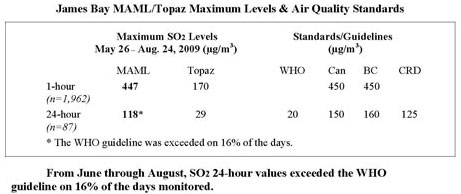Jan
28
The last issue of the Beacon, dated December 2009 - January 2010, contained an article titled Between the Smelter and the Pulp Mill. There was an error in the report. On page 6 of the Beacon, there was a table which included the maximum values identified in the initial analysis of the 2009 Mobile Air Monitoring Laboratory (MAML) air quality study. The table, and the paragraph directly following the table, should have indicated that the 24-hour WHO standard was exceeded 14 out of 89 days, or 15.7 % of the days for which data was collected (i.e. not 18% of the days). This error was not created by the Beacon or its staff. The misstatement, a result of conflicting information provided in the interim report, was in the information provided to the Beacon.
VIHA expects the final MAML final report to be completed by the end of February. At that time, it will be sent to Dr. Tom Kosatsky, Associate Director of Environmental Health Services, of the BC Centre for Disease Control. A health assessment report is anticipated by the end of March, 2010.
Marg Gardiner
JBNA

Canadian, BC and CRD emission standards are not current and in need of some serious update. Regulations set by the World Health Organization are current and are supported by medical professionals. They fully take into consideration the medical evidence regarding the damaging effects of ship pollution on the human physiology that result in respiratory disease. American EPA estimates put the human death toll at approximately 8,300 people per year in North America alone along the coastal regions. Hundreds of thousands more suffer respiratory distress requiring health care services.
Ships are permitted to burn fuel containing 45,000 parts per million sulphur. Gasoline for cars is at 80 ppm. Diesel fuel for trucks is at 15 ppm. It is more than apparent that the time for immediate action must take place today if we wish to preserve our health and that of our children.

The table seems to indicate that both the 1 hour and 24 hour SO2 emissions are lower than the Canadian, CRD and BC standards. So what's the issue?